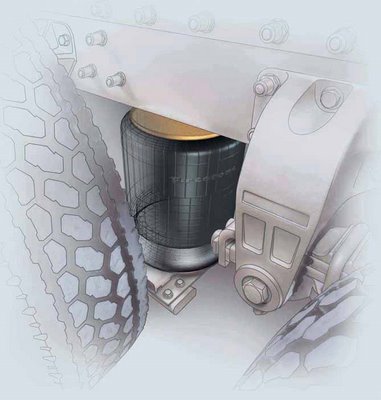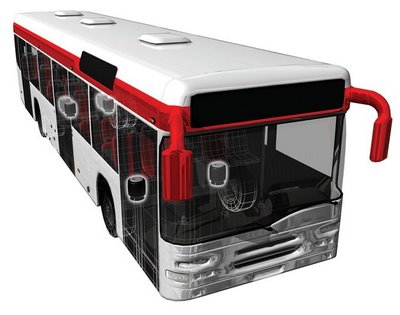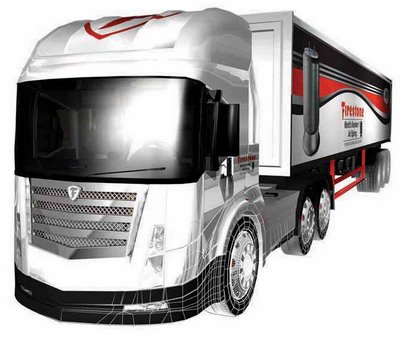 As we celebrate the 70th anniversary of the first rubber air spring this year, the global community of air spring manufacturers sits on the cusp of exciting growth potential throughout Asia. The economies of China and India especially are booming. India’s GDP growth in 2007-2008 was 9.1 per cent, pushing the national GDP over the $1 trillion mark. Such economic growth vastly increases the demand for new motorized vehicles of all types for transportation of people and goods. It also increases the demand for higher quality and performance from these vehicles.
As we celebrate the 70th anniversary of the first rubber air spring this year, the global community of air spring manufacturers sits on the cusp of exciting growth potential throughout Asia. The economies of China and India especially are booming. India’s GDP growth in 2007-2008 was 9.1 per cent, pushing the national GDP over the $1 trillion mark. Such economic growth vastly increases the demand for new motorized vehicles of all types for transportation of people and goods. It also increases the demand for higher quality and performance from these vehicles.
For this reason, air spring systems for automotive, trucking, off-road and rail applications are quickly gaining popularity among motor vehicle manufacturers in Asia. A vehicle with an air spring suspension provides a much smoother and more comfortable ride than one with the traditional mechanical leaf or coil spring suspension, adding extra safety for fragile cargo. Studies have shown that heavy-load vehicles with air springs also cause less wear and tear on road systems. The benefits from air spring systems are far-reaching. Simply put, air springs improve the ride and handling of the vehicle by providing cushions of air between the wheels and the frame. The spring assembly comprises an air-filled rubber cord structure that rolls up and down over a plastic or steel piston. As the vehicle travels over a roadway, the spring undergoes jolting bounces and rebounds and absorbs energy from the wheels. This cushioning effect increases the comfort of passengers and the security of cargo.
Simply put, air springs improve the ride and handling of the vehicle by providing cushions of air between the wheels and the frame. The spring assembly comprises an air-filled rubber cord structure that rolls up and down over a plastic or steel piston. As the vehicle travels over a roadway, the spring undergoes jolting bounces and rebounds and absorbs energy from the wheels. This cushioning effect increases the comfort of passengers and the security of cargo.
This article provides an overview of the air springs market in India and a forecast of what lies ahead. First, however, let’s begin with a background of air springs and product innovations over the years.
Firestone Industrial Products designed and patented the first rubber air spring in 1938, and by the 1950 air springs were being used in the US in the suspensions of buses and select General Motors automobiles. Though air springs gained little traction in the automotive industry initially, they made a good penetration into the truck and trailer market in the 1960s, where they are most widely used today.
In the US and Europe, the air springs market reached critical mass in the 1980s, as design and system improvements brought air springs back into the automotive industry for luxury vehicles, and manufacturers significantly strengthened their foothold in the truck and trailer industry. Since then, the uptrend in sales continued. In the latter half of the 1990s, Firestone and other air springs manufacturers got the opportunity to expand into Asia, with the emergence of growing economies of China and India. Air springs were introduced in India through suspensions for luxury buses. Luxury bus passengers soon became accustomed to smoother air rides, and today air spring suspensions are becoming a standard fitment in most luxury buses made in India, creating exponential growth in demand for the product.
In the latter half of the 1990s, Firestone and other air springs manufacturers got the opportunity to expand into Asia, with the emergence of growing economies of China and India. Air springs were introduced in India through suspensions for luxury buses. Luxury bus passengers soon became accustomed to smoother air rides, and today air spring suspensions are becoming a standard fitment in most luxury buses made in India, creating exponential growth in demand for the product.
As of 2007, Europe accounted for 52 per cent of the global air spring market for heavy-duty vehicles, and North America accounted for 31 per cent. Asia currently makes up 13 per cent of the market, a figure that is expected to increase to 20 per cent by 2013. The air spring industry is now seeing increased demand in the luxury bus, truck and trailer sectors across Asia from original equipment manufacturers (OEM) – and for very good reason.
The major outcome of the current Asian prosperity is the growth of heavy truck manufacturing in China and India, which along with Brazil, are the decade’s three fastest-growing truck markets in the world. In fact, if current trends continue, China is expected to overtake North America as the world’s largest truck manufacturer in the next three years.
China produced 343,072 trucks last year and India 119,160. Another sign of a thriving economy – infrastructure growth – largely drives India’s growth in motorized vehicle production.
Infrastructure growth
India’s National Highways Development Project (NHDP), a massive government infrastructure rehabilitation project, will produce 66,590 km of new roads and improved existing roads, all waiting for automobile, truck and bus travel. The first phase of the NHDP – the 5,846 km Golden Quadrilateral network of expansive express highways connecting Delhi, Mumbai, Kolkata and Chennai is almost 97 per cent complete (http://www.nhai.org/goldenquadrilateral.asp). Also in progress are Phase II of NHDP, the North-South-East-West Corridor highways (6,647 km); Phase III, involving the upgrading of 4,035 km of national highways; Phase IV, which will widen 6,500 km of existing four-lane highways; and Phase V, which will add 1,000 km of expressways. The estimated expense of this expansive project is $13.2 billion (Rs. 54,000 crores).
With such an investment, it’s certain that the Union Government would protect and preserve this world-class network of highways for as long as possible. One way to do this is by ensuring that heavy vehicles put only minimal wear and tear on roads, as they are typically responsible for 50 per cent of road maintenance costs. Air springs are an excellent solution to this problem.
The Organization for Economic Co-operation and Development (OECD) has reported that the use of air suspensions on motor vehicles increases the pavement life by 15 to 60 per cent, corresponding to increased static load of 4 to 12 per cent. Increased pavement life means significant reduction in road maintenance costs, which often comprise 90 per cent of annual road budgets in OECD countries.
Another factor increasing demand for trucks and air springs is transportation of goods from railway stations to their final destination. India still relies heavily on rail transportation for long-distance freight movement, and there are currently additions being made to its national rail system. Goods are moved at high speeds over long distances by rail, and trucks carry them the rest of the way. Air springs will also be needed on trailers used in inter-modal transport, where a trailer with goods is transported by train part of the way and hooked up to a truck for the remainder of the trip.
Transportation trends
Over the past 10 years, luxury bus passengers in India and China have noticed the difference between a bus with traditional mechanical leaf suspension and one that has an air suspension. Luxury buses with air suspensions provide a more comfortable ride, and bus riders are willing to pay the extra fare to ride on them. And, many more are able to do so, thanks to the thriving national economies. The luxury bus segment has provided a strong entry point for the air spring market into India and China. There is no better way to promote the virtues of air spring suspensions than having vehicle passengers experience these air rides themselves and spread the word. Once people understand how smooth an air spring-equipped vehicle rides, it is easy to understand the value in air suspensions for shipping fragile goods, such as poultry products, glass and luxury items.
Once people understand how smooth an air spring-equipped vehicle rides, it is easy to understand the value in air suspensions for shipping fragile goods, such as poultry products, glass and luxury items.
Major market segments
There are five major market segments in Asia where air springs are gaining popularity and will continue to grow in use:
• Truck suspensions – a fast-growing market. As the highway infrastructure grows and more manufacturers and truck repair outlets become educated about air springs, there will be a significant increase in demand from the OEM and the replacement parts sector.
• Trailer suspensions – also growing fast. Air spring-equipped trailers provide much safer transportation for goods than standard spring suspensions and limit wear and tear on roads.
• Cab mounts provide more comfort and less wear and tear, due to reduced vibrations in the cab of a large truck. Growth is slow, as they are still considered to be a luxury item.
• Seat springs provide extra sitting comfort. Though considered a luxury item, this segment is rapidly growing. Air-suspended seats and cab mounts have been identified as a means of reducing driver fatigue and increasing productivity.
• Helper/hybrid springs – these air springs supplement the existing springs to enhance ride quality, enable leveling of the vehicle and improve steering and brake control.
Future of air suspensions in India
With air springs, India has the advantage of adopting a product that has already gone through much improvement and development in other countries over the past 70 years. And, the nation is quickly becoming more technically savvy. With these factors in play, it is certain that air spring suspensions will experience rapid adoption in truck, trailer, bus and inter-modal segments.
In the years to come, air springs will likely have high penetration in trucks, trailers, lift axles, medium-size buses and helper springs for leveling. But the level of growth depends greatly on how well the air spring industry educates its customer base. For instance, highways in India have an extensive network of roadside repair shops for conventional suspensions. It is vitally important that this network be familiarized with repair and maintenance of any new technology products because this network is truly the backbone of the national service infrastructure.
With the current trends in Asia, however, we can expect that the air springs industry will see considerable growth, especially in India and China. Industry forecasts show that in 10 years, 50 per cent of all heavy commercial vehicles in India will have air spring suspensions, and 70 per cent of heavy commercial vehicles will have them in China.